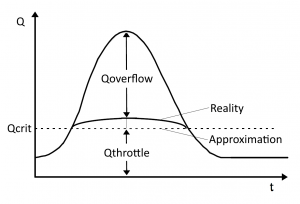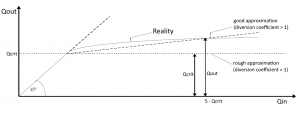Verzweigung/en: Unterschied zwischen den Versionen
Ferrao (Diskussion | Beiträge) (Die Seite wurde neu angelegt: „Regardless of the inflow, a constant division into two sequences Qab1 and Qab2 is made according to a certain percentage ratio. Also here, it is possible to ch…“) |
Keine Bearbeitungszusammenfassung |
||
| (23 dazwischenliegende Versionen von 3 Benutzern werden nicht angezeigt) | |||
| Zeile 1: | Zeile 1: | ||
<languages/> | <languages/> | ||
{{Navigation|vorher= | {{Navigation|vorher=Verbraucher|hoch=Beschreibung der Systemelemente|nachher=Speicher}} | ||
[[ | [[Datei:Systemelement005.png|50px|none]] | ||
Diversions are used to divide an inflow into two outflows according to a distribution rule. This can be used to model structures that withdraw water from rivers for water supply or irrigation purposes, branches in canals, diversions at the inlet or outlet of reservoirs, stormwater overflows, etc. | |||
[[Datei:Schema | [[Datei:Schema Verzweigung_EN.png]] | ||
Four approaches are possible for defining the distribution rule. | |||
==Threshold | ==Threshold Value (Option 1)== | ||
[[ | [[Datei:Abflussaufteilung_nach_Schwellwertkonzept_EN.png|thumb|Discharge distribution using a threshold value]] | ||
[[ | In this case the second outflow only becomes active if the inflow exceeds the threshold of <code>Qcrit</code>. In the threshold value approach, the 2nd outlet (e.g. stormwater overflow) is only activated once a critical inflow <code>Qcrit</code> is exceeded, causing the throttled outflow to back up, reaching the overflow threshold. Since in reality a perfect division of the outflows after reaching the threshold value is usually never achieved, a diversion coefficient can also be specified in order to better represent actual conditions. | ||
It is defined as: <math>\mbox{ | [[Datei:Trennschärfe_EN.png|thumb|Definition of the diversion coefficient in Talsim-NG]] | ||
It is defined as: <math>\mbox{diversion coefficient}= \frac{Q_{in}(Q_{out}=5 \cdot Q_{crit})}{Q_{crit}}</math> | |||
== Percentage | == Percentage Distribution (Option 2)== | ||
With this approach, the inflow is split into two outflows <code>Qout1</code> and <code>Qout2</code> according to a fixed percentage ratio. | |||
== | ==Function (Option 3)== | ||
A relationship determined using hydraulic calculations or derived from operating rules between the discharge <code>Qout1</code> and the inflow can be specified in the form of a function. The second outlet <code>Qab2</code> will then output the remaining discharge. | |||
==Rules (Option 4)== | |||
Either of the two outlets can be controlled by scaling a value with a [[Special:MyLanguage/Betriebsplan|system state]], optionally combined with a daily, weekly and/or annual pattern. The other outlet will then output the remaining discharge. | |||
Aktuelle Version vom 26. November 2020, 12:29 Uhr
Diversions are used to divide an inflow into two outflows according to a distribution rule. This can be used to model structures that withdraw water from rivers for water supply or irrigation purposes, branches in canals, diversions at the inlet or outlet of reservoirs, stormwater overflows, etc.
Four approaches are possible for defining the distribution rule.
Threshold Value (Option 1)
In this case the second outflow only becomes active if the inflow exceeds the threshold of Qcrit. In the threshold value approach, the 2nd outlet (e.g. stormwater overflow) is only activated once a critical inflow Qcrit is exceeded, causing the throttled outflow to back up, reaching the overflow threshold. Since in reality a perfect division of the outflows after reaching the threshold value is usually never achieved, a diversion coefficient can also be specified in order to better represent actual conditions.
It is defined as: [math]\displaystyle{ \mbox{diversion coefficient}= \frac{Q_{in}(Q_{out}=5 \cdot Q_{crit})}{Q_{crit}} }[/math]
Percentage Distribution (Option 2)
With this approach, the inflow is split into two outflows Qout1 and Qout2 according to a fixed percentage ratio.
Function (Option 3)
A relationship determined using hydraulic calculations or derived from operating rules between the discharge Qout1 and the inflow can be specified in the form of a function. The second outlet Qab2 will then output the remaining discharge.
Rules (Option 4)
Either of the two outlets can be controlled by scaling a value with a system state, optionally combined with a daily, weekly and/or annual pattern. The other outlet will then output the remaining discharge.


